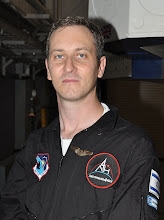 |
| Space Shuttle Discovery on her way to the launch Pad, taken by Larry Tanner |
Launch Buzz
There is something special about the
Space Shuttles that didn't exist when every rocket and capsule were built as disposable spacecraft. Just like we get attached to our cars (OK, maybe it's just me), we got attached to these vehicles that at least in the 1980s and 1990s symbolized a revamped pursuit of space and getting one step closer to space travel as we'd really like to experience it (whenever, wherever - à la Star Trek with
some extrapolation).
Every Space Shuttle launch causes a special buzz among space enthusiasts, who in recent years have had online venues for their thoughts and experiences.
Blog posts are written,
pictures are uploaded (also
here) and the social network is flooded with copious amounts of updates. NASA itself joined the party in several ways - allowing the public to vote for
astronaut wake-up songs, the opportunity to
upload one's face to space and
NASA Tweetups like the one
I attended last May, where 150 lucky people become journalists of the best kind - supportive and enthusiastic, almost NASA ambassadors to the world, all posting to Twitter using the
#NASATweetup tag.
STS-133 and Space Shuttle
Discovery are no different. In fact, since after this launch there will be only one more (
maybe two) Space Shuttle launches before the program reaches its planned shutdown, the normal jitter and excitement seems to be even greater. The NASA Tweetup event even got its
own blog created by
Nathan Bergey. This last flight of Discovery will also bring a new dweller to the ISS, one that doesn't consume oxygen or water -
Robonaut2, the first first dexterous humanoid robot in space, aimed at providing another pair of hands for repetitive and maintenance tasks that would otherwise require people, without making changes to the original component, for example an air filter.
An Informal Poll
Since you're reading these lines it would be almost moot to ask if you know when Discovery is being launched and you obviously know the name of the Space Shuttle being launched. What I'm wondering about is how much of that is known to your friends and family, that might not share the same enthusiasm for space.
My request to you is this: Ask your family, coworkers and friends:
- Which Space Shuttle is getting ready for launch?
- When is the next launch?
- How many Space Shuttle launches remain after this one?
- What mission number is it going to be?
Please report back by commenting on this post (no need for names, just people's answers).
Update: Commenting disallowed, as Discovery
successfully launched on February 24 2011. Thank you everyone who participated!
After the launch I will tally your reports in an attempt to answer this question:
Have NASA and the space enthusiast community been successful at keeping space exploration on people's minds in such a critical era of economic woes and budgetary battles?





 Space Shuttle Launch Poll Results
Space Shuttle Launch Poll Results